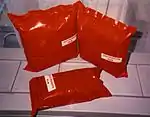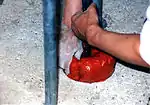Firestop pillow
Firestop pillows are passive fire protection items, used for firestopping holes in wall or floor assemblies required to have a fire-resistance rating. The products must be used in accordance with a valid certification listing, subject to listing and approval use and compliance.




General use
Firestop pillows are used in openings that require frequent access (e.g., cable changes), requiring the removal of the firestopping and resealing after the changes are completed.
Technical issues and common misconceptions
There are three types of firestop pillows:
- rockwool batts with intumescent resin inside plastic bags
- vermiculite with intumescent graphite inside of fibreglass bags
- intumescent foam rubber
A hose-stream test, which is mandatory for firestops in the United States and often used in Canada, qualifies the openings and firestop pillow combinations as effective against the force of a 30 psi water stream. The pillows are compressed to provide sufficient strength to withstand the hose stream impact of the test. To accommodate larger openings that can allow the pillows to become dislodged, wire mesh is sometimes used. As a particular compression rate is required for each hole, the area of the opening less the area covered by the penetrating items is calculated, resulting in the number and size of the pillows to be installed. Without this information, there is no evidence the installation conforms with the requirements of the certification listing. As penetrants are exchanged or removed, this calculation is redone to maintain compliance with the certification listing.
An installation that meets listing and approval use and compliance usually requires pillow coverage between cables. The type and size of the pillows used must be matched to the exact cabling per the certification listing. Smoke will migrate through the interior of a cable bundle if the bundle is not opened up and sealed on the inside during the installation of any firestop, regardless of whether the firestop is intumescent or not. If mesh is used, mechanical fasteners are required, potentially negating the perceived benefits of fast installation and "re-enterability" that is typically purported to be provided by this technology.
Intumescent foam rubber firestops utilize Bayer Fomox intumescent foam, which can be extruded into various shapes. For countries that use a hose-stream test, the Fomox is reinforced with intumescent graphite, whereas for those who do not use a hose-stream, this ingredient is omitted.
Repairs/maintenance
Pillows may present an opportunity for vandalism if not properly secured. Repairs must conform to the original certification listing.
Smokeproofing
Field installations of firestop pillows do not offer significant resistance to air pressure differences or smoke penetration, as is evidenced by the L ratings of North American certification listings of firestops.
Technical concepts
The intumescent resins in batt-based firestop pillows contains hydrates, or chemically bound water. On the fire side, the plastic bag burns off exposing the intumescent to the fire, which releases the water in the form of vapour or steam. The steam rises and hits the plastic bag interior on the unexposed side, where it condenses back to water, and runs back down to cool the installation below. Batt-based pillows are held in place by compressing them, allowing friction to restrain them. If replaced a sufficient number of times, the pillows will retain a permanent compression, requiring their replacement with new components.
For the fabric bag based pillows, the vermiculite, the fabric bag and the graphite are noncombustible. The graphite expands but forms no bond with anything around it, unlike the resin-based intumescents. There is also no significant release of chemically bound water. Usually the bags are not entirely filled and cannot be significantly compressed, requiring mesh or grid installations to stay in place.
The Fomox-based pillows intumesce.